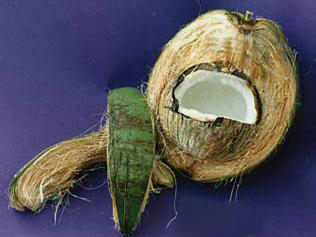| PANEL 3
|
| |
| History of retting, traditional process of retting-starting from coconut husk collection: |
 |
- The cover part of the coconut fruit is known as
husk.
- The husk comprises of three parts namely,
covering with a leathery peel on the surface, coir
fibres and coir pith.
- The ratio of fibres to pith is generally 1:2.
|
| Retting |
 |
- Husks are suspended in brackish water for
a period of 6-11 months to separate fibres from the matrix by dissolving the pectin.
- The husks are beaten by wooden mallets
fro separating fibres and pith.
- The fibre quality is superior when retted
in the water having ebb and flow.
|
| Problem with Traditional retting process- |
| Diagrams to support matter |
 |
- Damage to the environment while carrying out retting because of release of green house gases
- Drudgery and health hazard involved in the process of dipping and taking out husks and subsequently beating those by wooden mallets by women workers.
|
| |





